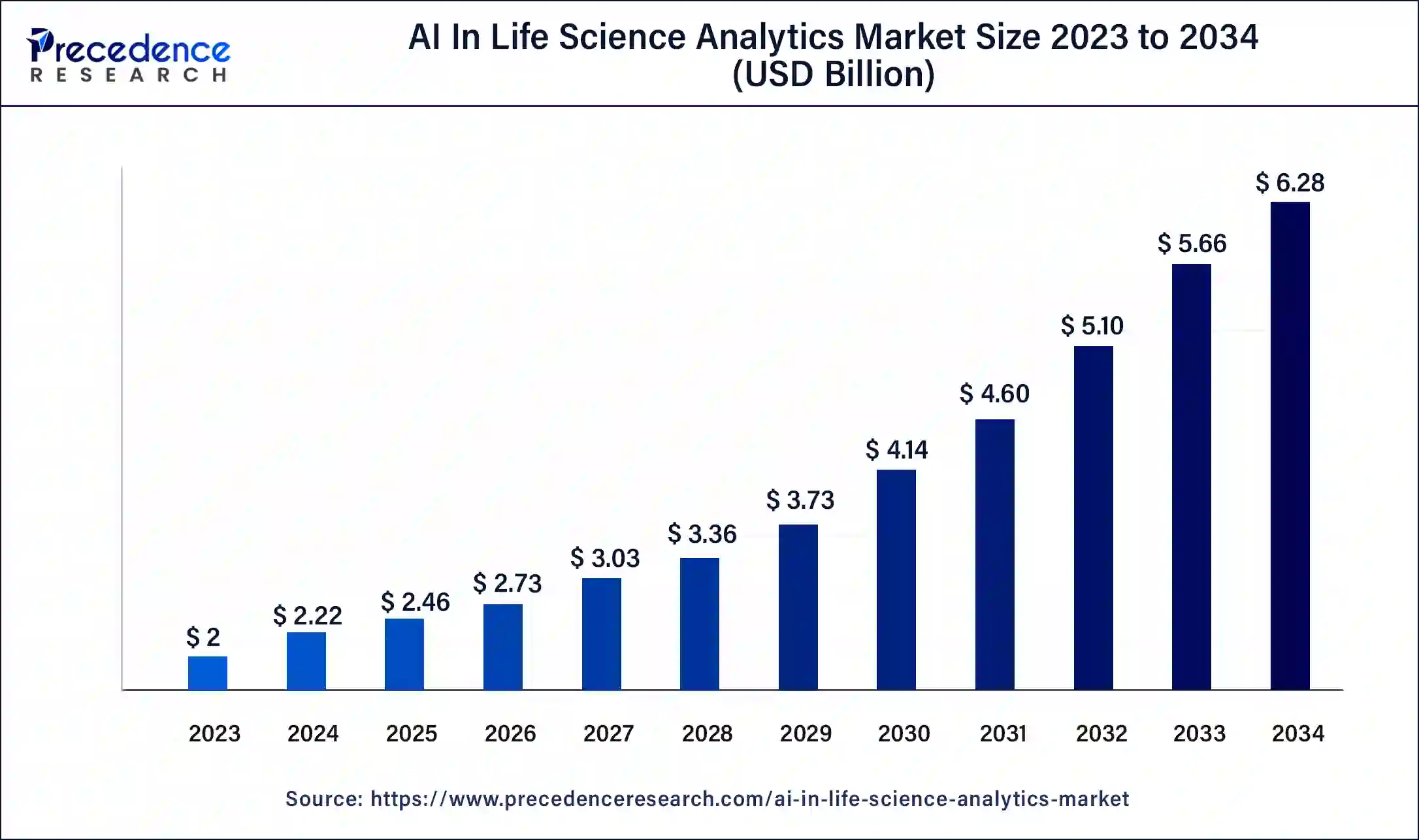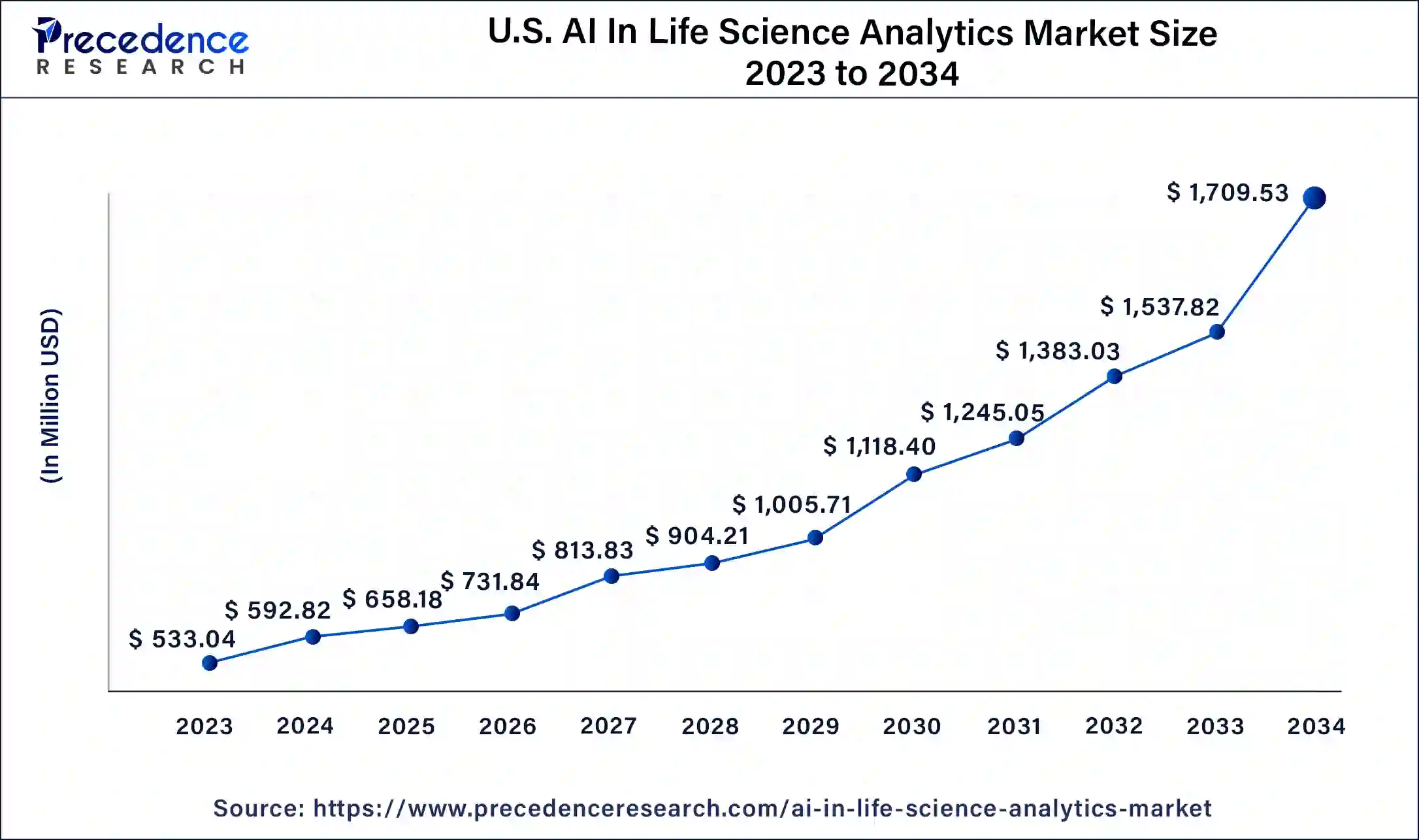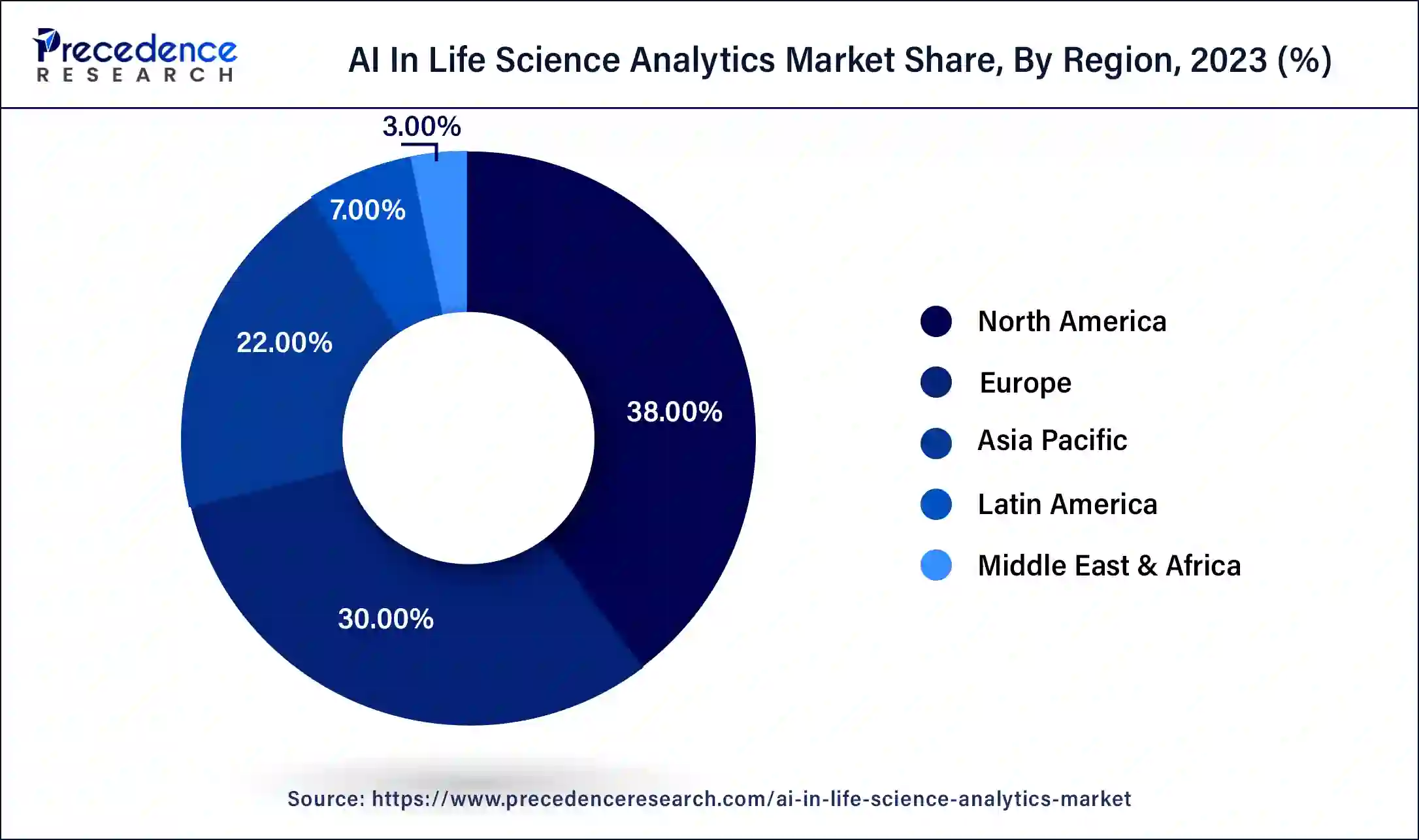January 2025
The global AI in life science analytics market size was USD 2 billion in 2023, calculated at USD 2.22 billion in 2024 and is projected to surpass around USD 6.28 billion by 2034, expanding at a CAGR of 11% from 2024 to 2034.
The global AI in life science analytics market size accounted for USD 2.22 billion in 2024 and is expected to be worth around USD 6.28 billion by 2034, at a CAGR of 11% from 2024 to 2034. The North America AI in life science analytics market size reached USD 760 million in 2023.

The U.S. AI in life science analytics market size was estimated at USD 533.04 million in 2023 and is predicted to be worth around USD 1,709.53 million by 2034, at a CAGR of 11.2% from 2024 to 2034.

North America has dominated the market with over 38% share in 2023. North America is a significant player in the AI in the life science analytics market, driven by advanced technological infrastructure, a robust healthcare system, and a thriving life sciences sector. The region is characterized by a high level of research and development activities, collaborations between technology companies and healthcare institutions, and a strong focus on innovation.
Asia-Pacific is estimated to observe the fastest expansion. This significant growth in the artificial intelligence in life science analytics market across Asia-Pacific, driven by advancements in technology, a rising focus on healthcare innovation, and increased investments in research and development. Countries in the region, such as China, Japan, and India, are at the forefront of adopting AI technologies in the life sciences sector.

AI in life science analytics refers to the application of artificial intelligence (AI) techniques and technologies in the field of life sciences data analysis. This integration of AI in life science analytics is aimed at leveraging advanced computational methods to extract meaningful insights from complex biological, clinical, and healthcare datasets. The application of AI in life science analytics holds great promise for advancing research, improving healthcare outcomes, and enhancing the efficiency of processes in the life sciences and healthcare sectors. As technology continues to evolve, the integration of AI is expected to further revolutionize how data is analyzed and utilized in these critical domains.
AI in life science analytics helps in improving healthcare outcomes and enhancing the efficiency of processes in the life sciences and healthcare sectors.
Life science analytics involves the use of data analysis tools and techniques to extract meaningful insights from large volumes of biological, clinical, and healthcare data. AI plays a crucial role in enhancing the capabilities of life science analytics by providing advanced computational and learning abilities. As the field continues to evolve, the AI in life science analytics market is expected to grow, driven by the increasing availability of data, advancements in AI technologies, and the need for more precise and personalized approaches in healthcare and life sciences.
| Report Coverage | Details |
| Growth Rate from 2024 to 2034 | CAGR of 11% |
| Market Size in 2023 | USD 2 Billion |
| Market Size in 2024 | USD 2.22 Billion |
| Market Size by 2034 | USD 6.28 Billion |
| Largest Market | North America |
| Base Year | 2023 |
| Forecast Period | 2024 to 2034 |
| Segments Covered | By Component, By End-user, By Application, and By Deployment |
| Regions Covered | North America, Europe, Asia-Pacific, Latin America, and Middle East & Africa |
Explosion of data in life sciences
The explosion of data in the life sciences has become a driving force behind the escalating demand for AI in life science analytics market. With unprecedented volumes of biological, clinical, and healthcare data being generated from sources such as genomics, proteomics, and electronic health records, traditional methods of analysis are proving insufficient. AI, with its advanced computational capabilities, has emerged as a transformative solution, adept at handling and extracting meaningful insights from these massive and complex datasets.
The vast amounts of data offer unprecedented opportunities for discovering patterns, predicting disease outcomes, and optimizing various aspects of healthcare and life sciences research. AI facilitates the integration and analysis of diverse data types, providing researchers, healthcare professionals, and pharmaceutical companies with the tools to unlock valuable insights. From expediting drug discovery processes to enabling personalized medicine through the analysis of individual patient data, AI in life science analytics is instrumental in navigating and deriving actionable intelligence from the data deluge.
As the life sciences industry continues to harness the power of AI, the demand for sophisticated analytics solutions is set to grow, reshaping the landscape of healthcare and advancing our understanding of complex biological systems.
Limited adoption in certain healthcare settings
The limited adoption of AI in certain healthcare settings stands as a formidable restraint, potentially hindering the demand for AI in life science analytics market. While the transformative potential of AI in revolutionizing healthcare is evident, the integration of these advanced technologies encounters barriers in smaller or less technologically advanced healthcare institutions. Limited resources, both in terms of financial investment and skilled personnel, contribute to a slower pace of adoption in these settings. The intricacies of implementing AI systems, including the need for specialized training and infrastructure upgrades, further exacerbate challenges.
Resistance to change within the traditionally conservative healthcare industry also plays a role. Established practices and workflows, deeply ingrained in the culture of some institutions, can be resistant to disruption, especially when there is a lack of familiarity or understanding of AI technologies. Overcoming these hurdles requires concerted efforts in education, training, and infrastructure development to ensure that healthcare providers, regardless of their size or technological sophistication, can effectively leverage the benefits of AI in life sciences analytics. Bridging this gap in adoption is critical to realizing the widespread positive impact of AI on patient care, research, and overall healthcare efficiency. As the industry addresses these challenges, there is an opportunity for innovative solutions and strategies to facilitate broader integration of AI in diverse healthcare settings.
Drug discovery and development
The realm of drug discovery and development stands as a fertile ground for the burgeoning opportunity in the AI in life science analytics market. The traditional drug development process is time-consuming, resource-intensive, and often marked by high failure rates. AI emerges as a transformative force in this arena, offering unparalleled capabilities to expedite the identification and optimization of potential drug candidates. Machine learning algorithms can analyze vast datasets encompassing molecular structures, genomics, and clinical trial outcomes, unraveling complex patterns and relationships that would be challenging for conventional methods.
AI's ability to predict drug efficacy, assess safety profiles, and optimize experimental designs significantly streamlines the drug development pipeline. By facilitating target identification, lead optimization, and biomarker discovery, AI not only accelerates the time to market for new therapeutics but also holds the promise of reducing the associated costs. This transformative impact on drug discovery is particularly crucial in addressing pressing global health challenges, allowing for the rapid development of treatments and vaccines, as underscored by the urgency of the recent COVID-19 pandemic. As pharmaceutical and biotech companies increasingly recognize the potential of AI-driven analytics in revolutionizing drug development, the demand for advanced life science analytics solutions continues to grow, opening up a substantial and exciting opportunity within the AI in life science analytics market.
The services segment had the highest market share of 47% in 2023. The services segment includes consulting, implementation, training, and maintenance services provided by vendors and experts in the field. It encompasses the human and advisory elements necessary for the successful deployment and utilization of AI solutions. It plays a crucial role in supporting organizations in adopting and leveraging AI in life science analytics. Consulting services help tailor AI solutions to specific needs, implementation services ensure seamless integration, training services enhance user proficiency, and maintenance services ensure ongoing support and optimization.
In 2023, the cloud segment had the highest market share of 51% and is anticipated to expand fastest over the projected period. Cloud deployment involves hosting AI in life science analytics solutions on cloud platforms provided by third-party service providers. The software and associated resources are accessed and managed over the Internet.
The solutions offer scalability, flexibility, and accessibility. Organizations can leverage the computing power and storage capabilities of cloud providers, reducing the need for extensive on-site infrastructure. This deployment model is particularly suitable for those seeking agility and the ability to scale resources as needed.
The sales and marketing support segment has held the highest market share of 43% in 2023. This segment focuses on the application of AI in supporting sales and marketing efforts within the life sciences industry. It includes customer relationship management, targeted marketing campaigns, and sales optimization. AI aids in analyzing customer behavior, tailoring marketing strategies, and optimizing sales processes. It can provide valuable insights for personalized marketing, customer engagement, and lead generation.
The research and development segment is anticipated to expand fastest over the projected period. AI plays a pivotal role in research and development activities in the life sciences, encompassing drug discovery, genomics, and other scientific endeavors. In R&D, AI accelerates the identification of potential drug candidates, analyzes genomic data, and supports various stages of the drug development pipeline. It enhances the efficiency of experiments, data analysis, and decision-making in research.
In 2023, the pharmaceutical segment had the highest market share of 46% on the basis of the end-use. The pharmaceutical sector encompasses companies involved in the research, development, manufacturing, and marketing of pharmaceutical drugs. AI in pharmaceuticals is instrumental in drug discovery, clinical trial optimization, and enhancing various aspects of the drug development lifecycle. It contributes to accelerating research processes and improving the overall efficiency of pharmaceutical operations.
The biotechnology segment is anticipated to expand at the fastest CAGR of 11.2% over the projected period. Biotechnology companies focus on leveraging biological systems, organisms, or derivatives to develop products and technologies for various applications, including healthcare. AI in biotechnology supports genomic analysis, personalized medicine, and advancements in bioinformatics. It aids in optimizing processes related to genetic engineering, gene therapy, and other biotechnological applications.
Segments Covered in the Report
By Component
By End-user
By Application
By Deployment
By Geography
For inquiries regarding discounts, bulk purchases, or customization requests, please contact us at sales@precedenceresearch.com
No cookie-cutter, only authentic analysis – take the 1st step to become a Precedence Research client
January 2025
January 2025
June 2024
January 2025